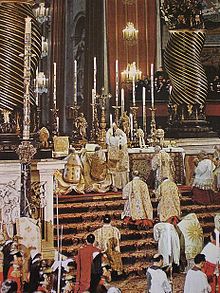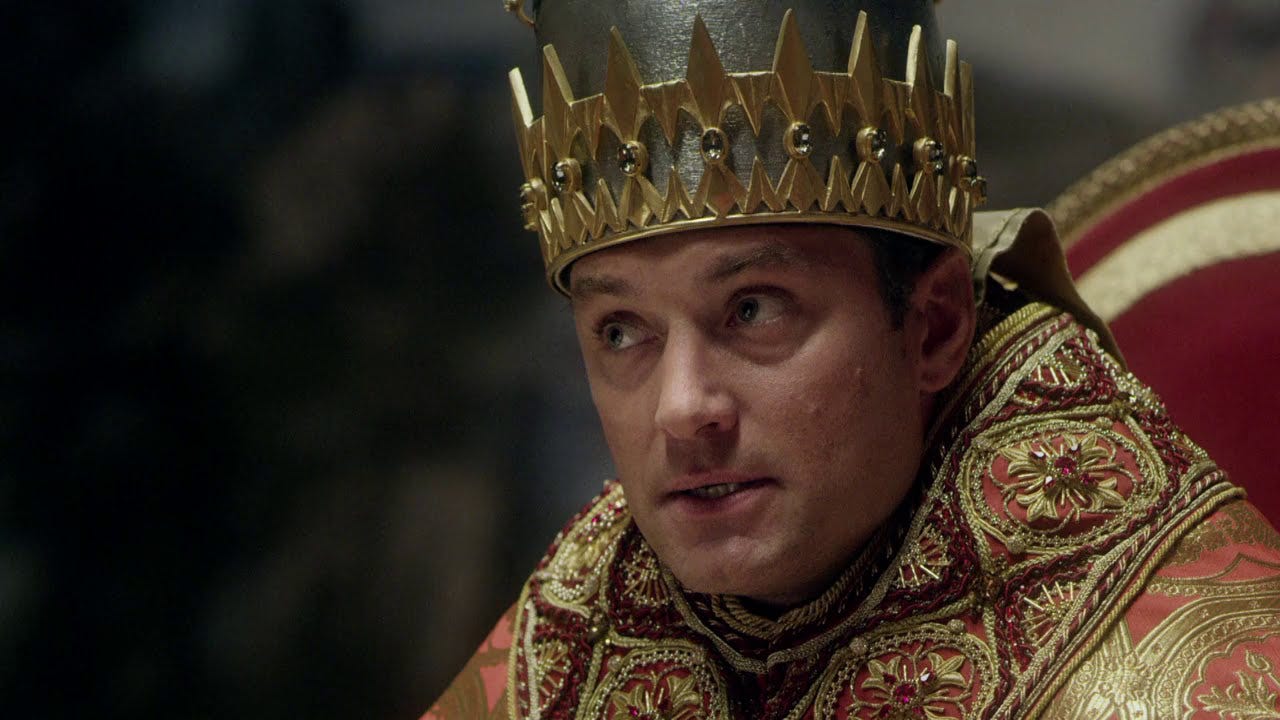 |
St. Thomas triumphs over that quintessential innovator Averroes: no wonder the Modernists fear him.
(Bennozzo Gozzoli, Il Triunfo di San Tommaso, detail)
|
How does one use St. Thomas's writings fruitfully, even if he is unable to devote years to an effort at preparation? This is the question we ended Part 1 with, after having listed a few pitfalls in reading the
Summa or any of the Saint's works. This time, we want to take a brief look at some aspects of his writings that even a minor article in the Summa can provide. And so, like good Catholics, let's begin at the beginning: Tradition.
Divus Thomas: Defender of Sacred Tradition
Every Rad Trad (affectionately so called) holds Holy Church's traditions very dear. The clue is in the (nick-) name. It follows--logically enough--that all such would seek to emulate the school of a Doctor who
preeminently defends the writings of the Saints and Catholic tradition in general. We have no farther to look than the Angel of the Schools, St. Thomas Aquinas. Indeed, this is the first thing for us to consider and appreciate when we read St. Thomas: his veneration and defense of the Fathers, the Doctors, and all the traditions of the Church. If there is some error or ambiguity, he corrects or clarifies without ever explicitly accusing them of error, let alone of fault.
Indicative of this truth is the testimony of Albertanus of Brescia, a thirteenth-century witness. He relates that one day while praying before the altar of the Virgin, he beheld with wonder two men in glory, one in pontificals, the other in the Dominican habit. The one vested as a bishop spoke to him:
"Why are you amazed, O Albert? I am Augustine, Doctor of the Church, who have been sent to declare the glory of St. Thomas. With me now, he has followed in all things the doctrine of the Apostles and mine own, and he has wonderfully enlightened the entire Church of God with the thunderbolts [fulgoribus] of his teaching."
(Incidentally, this vision is the source of the iconographic detail of a shining gem or disc on St. Thomas's bosom.)
But there is evidence in the Saint's writings as well. Consider, for example, Aquinas' defense of a "legend" concerning St. Gregory, who was said (according to St. John Damascene and others) to have raised the Emperor Trajan from the dead, so that he might then be baptized and so obtain salvation.
 |
| The Emperor Trajan: shall we, please God, all meet together with him one day in heaven? |
This is a difficulty (or "problematic" as we say nowadays) for the doctrine of the eternity of hell; and a mere ideologue would dismiss it as "not in Scripture" or "merely a legend" or some other Herbert Thurston-approved approach to the extraordinary. The Angelic Doctor, however, would not dream of dismissing something handed down by the Fathers out of hand: and so in the so-called Supplement to the Summa (actually, the relevant material from his commentary on the
Sentences), St. Thomas (
Supp., Q. 71, art. 5, ad 5um) explains how this story could be in line with the Church's teaching concerning the finality of death and the eternity of hell. (And please note, at the end of the reply to the 5th objection St. Thomas's reverent use of St. Augustine's beautiful words in all such matters that seem to exceed what we deem possible.)
 |
| St. Dionysius, pray for us in these dark times! |
St. Thomas also wrote a commentary on a work of that mysterious writer nowadays known (almost universally) as Pseudo-Dionysius. In the Angelic Doctor's days, though, he was better known as Blessed Dionysius, the self-same as the Areopagite converted by St. Paul's preaching, friend of the Apostles, and witness of the Dormition of the Most Holy God-Bearer, the Virgin Mother. In early modern times, though, he was dismissed as a pious fraud, but one with a rather interesting Neo-Platonic take on Christian "mysticism." The
1909 Catholic Encyclopedia (beloved of Trad-Catholics everywhere) takes this line. But not the great St. Thomas! It would be hard to exaggerate the veneration accorded to the writings of St. Dionysius during the Middle Ages. And rightly so, if the Scholastics held that they were the writings of one who conversed with St. Paul, who sat at the feet of the Apostles, and who expounded on things lofty and great. Textual criticism was no less available to St. Thomas than to the "moderns"; ditto, a familiarity with Neo-Platonism and Platonic thought in general. The distinction between the Saint and the Critics, of course, lies in the love and reverential awe that the former held for tradition. (The latter--I'm all but convinced--used St. Dionysius as a kind of dry run for the assault on the authenticity of Sacred Scripture. But I digress.)
And so, the first thing to appreciate in reading through a typical article of the Summa is St. Thomas's veneration and defense of the Scriptures, the Fathers, and the dogma of the Church. How can
X be asserted--the initial objections often read in effect--if St. Augustine said
non-X. Likewise, the
Sed contra will provide a counterweight (usually decisive) to all the objections with the authority of Scripture (or of a Father) in a way that goes to the very heart of the question under discussion. The
corpus (or main argument) further explicates the question, and then the answers to the objections will always preserve the true, or at least more accurate, understanding of the citation from St. Augustine (or whichever authority).
St. Thomas Always Speaks Most Formally
I realize this dictum sounds both fussy and obscure at the same time. It should not be read that way, nevertheless. It simply means that St. Thomas addresses a question according to the precise, or "formal" (as in "form," i.e. essence or nature), sense of the terms involved. For instance, when he discusses the unity of the world (
mundus), he means--something clearer in the Latin word, and in the Greek
cosmos, for that matter--the entire creation, as described in the Six Days of Genesis. We, on the other hand, can and do speak of the "world" as referring to the earth as such; sometimes as referring to humanity in general; and sometimes in reference to the sinful members of the human race ("the world, the flesh, and the devil"). If there were that kind of ambiguity interlaced with the discussions in, say, the Summa--or if we ourselves import that kind of ambiguity--there would be abundant occasions of confusion and arguing at cross-purposes. Fortunately, we can set all that aside and realize that St. Thomas always speaks (and so we, dear readers, must try to read him)
most formally.
 |
| Articulate and articulating: Divus Thomas insisted on precision. |
If, for example, one were to delve into the Summa and turned (at random, of course) to the
Tertia Pars, Question 1, article 1, he would read the following:
It would seem that it was not fitting for God to become incarnate: since God from all eternity is the essence of goodness itself, it was best for Him to be as He had been from all eternity [i.e. without flesh or human nature].
After St. Thomas's explanation in the body of the article (or the
corpus), he addresses this opening objection:
To each thing that which belongs to it by virtue of its nature is fitting; and so, reason is fitting to man, since this belongs to him because he is of a rational nature. But the nature of God is goodness, as is clear from [Saint] Dionysius [in the De divinis nominibus, i]. Hence, what belongs to the essence of goodness befits God, but it belongs to the essence of goodness to communicate itself to others, as is obvious from Dionysius [De divinis nominibus, iv].
I have taken the liberty of highlighting in red terms that (in English, at least) could be construed other than according to their
formal meanings. Some examples of what I mean:
1. St. Thomas is not arguing here that God's goodness is equivocal with other goods in creation;
2. he does not argue that essential properties, derived from a thing's nature, are merely "fitting" to that thing (rationality to man);
3. and he does not make the case that God was bound to become incarnate because that follows from His divine goodness.
In fact, the arguments in these three examples are all addressed elsewhere in the Summa. But even if we have not undertaken a methodical page-by-page approach to reading the Summa [although ... an article a day keeps heresy away--so they say], if we endeavor to read this article (III, Q. 1, a. 1) according to the most formal sense of the terms, we won't go too far astray. So--to take just one example--"reason" is not the same as "rational nature": reason is the
act of a rational nature, or the actuation of the potency for the same in a rational nature. Nevertheless--if we keep "reason" in this most formal sense--we can agree that it is most fitting for man to possess reason. (This saves us from concluding that infants or the insane are not human because their reason is absent or never developed.)
Likewise, to say it "belongs" to the essence of the good to communicate itself to others does not, in the most formal sense, imply whether such a self-communication has taken place. (This avoids the error of the Franciscan School when they held that the Incarnation was absolutely necessary because of God's goodness and His creation, thus rendering the connection to salvation purely casual.)
There is a
third means by which we can read St. Thomas profitably without a long period of preparation and study and that is to rely on his friends: I mean, the great Thomistic
Commentators, from Capreolus (whose name I unworthily have appropriated) down to Garrigou-Lagrange. More about them next time!
Finally, since this is being published on his feast day and on a day in Lent, allow me to recount what to me is one of the most endearing stories told about the Angelic Doctor, one that allows us maybe to form a more complete picture of this great soul. It was said (by his long-term companion in the religious life) that the Saint could never hear the words of the "
Media vita" sung without being moved to tears. And since this antiphon is not necessarily easy to find, I give it here, so that you can picture this colossus of intellectual depth and accomplishment openly weeping in the choir stalls as he listens:
In the midst of life, we are in death: whom shall we seek as a Helper except thee, O Lord? Thou who art justly angered by our sins, O Holy God, O Holy and Mighty One, O Holy and merciful Saviour: deliver us not up to the bitterness of Death!
In Thee did our Fathers hope; they hoped, and Thou didst deliver them. Our Fathers cried out to Thee, they cried out and were not put to shame. O Holy God, glory to the Father, and to the Son, and to the Holy Spirit: as it was in the beginning, is now and ever shall be, world without end. Amen.



















